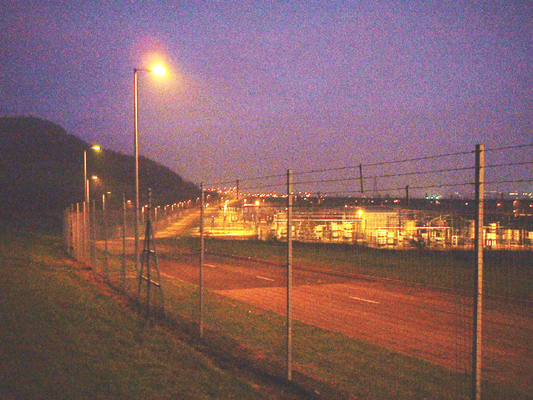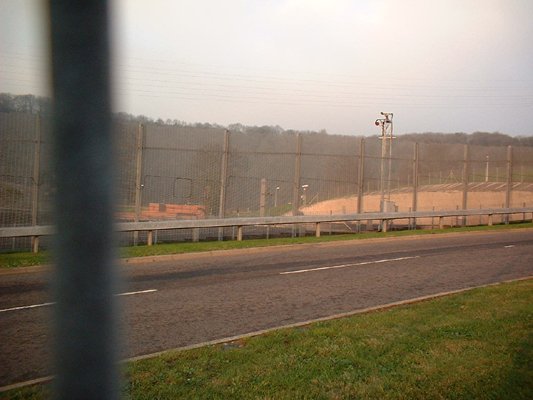Reverse Authentification June 2002
Florian Schneider

A coyote looks like a medium-sized dog with a long, tapering muzzle, and erect pointed ears. Its thick coat is greyish, with reddish tinges to the legs and ears, and a lighter-coloured belly and neck. Among humans, coyotes have an ambiguous reputation, being considered on the one hand crafty, sly and cowardly, and on the other tireless and highly adaptive.
To some the coyote epitomises perfidy, to others it symbolises imagination, independence and a powerful will to survive. Native Americans revere the coyote as a godhead; settlers only see their livestock in danger, and denounce the coyote as evil.
In the border area between the United States and Mexico the term coyote also refers to a very special type of human being: the traffickers in migrants, who for a fee offer their knowledge of how to cross a state border without the usual paperwork.
In his project, BorderXing Guide, Heath Bunting plays the role of a coyote, or rather, a virtual coyote, committed to the principle of open source. Bunting collects border experiences, literally so: for several months he has been walking across borders between European countries in many kinds of location, including forests, rivers, mountains and tunnels. He painstakingly documents the routes he follows, and makes a detailed record of all his movements.
BorderXing Guide is thus a manual written on foot. The work’s web interface promises to provide full information about Bunting’s unofficial border crossings. But in this case ‘providing’' has a very particular meaning. It goes far beyond making information available by just putting it online and waiting to see what happens.
A coyote wouldn’t be a coyote and Bunting wouldn’t be Bunting, if he were not always a half-step ahead. In BorderXing Guide, as in most of his works over the last few years he treats his material in an entirely personal way. For very practical reasons the presentation of BorderXing Guide is based on a carefully calculated politics of public relations.

Anyone trying to access the website of the BorderXing Guide project is initially doomed to disappointment, since there is no access for unauthorised visitors. Instead they are given a list of names and postal addresses of contacts worldwide. The BorderXing Guide can be visited only from this growing but exclusive list of ‘social clients’' who have a static IP (Internet Protocol) address and who, most notably, have gained the artist’s confidence.
Bunting takes these things very seriously, and demands considerable patience and understanding from the potential users of the BorderXing Guide, both for the fact that they are being refused at the entrance and because they require a certain appreciation of how to preserve, develop and mutually share a precarious knowledge without compromising the project as a whole.
In the western world today the more easily money and goods flow between nations, the more those nations close their doors to border crossers, whether they are fleeing persecution or seeking a change in their luck. Bunting’s BorderXing Guide acknowledges this paradox, evoking the everyday experience of illegal border crossers in a process of reverse authentification.
Suddenly, those visiting a gallery or museum website out of interest or curiosity find they have to prove their credentials. But this tactical recreation of a political reality is absolutely reasonable in the circumstances: the knowledge of how to cross borders has to remain a secret until and unless there is a high degree of trust.
For some time awareness of the issue of borders has been gaining currency among artists, curators and art institutions. There is a long tradition of US and Mexican artists dealing with the 2000-mile long border between the two nations. Dating from the early 1980s there is a whole history of border art that has addressed the power relations that structure intercultural exchange. More recently, the border has become a metaphor in debates, encompassing a variety of political, cultural and artistic approaches, on how societies are changing under the pressures of informalisation and globalisation.
On the face of it, BorderXing Guide systematically ignores the current metaphoric dimension of borders. In this extended personal experiment he downgrades their blinding omnipresence to the banality of just crossing a line. Bunting in fact reverse engineers the metaphorical overload of all the festivals and exhibitions which are nowadays flirting with the ambiguity of borders, towards a very concrete and singular practice. Although BorderXing Guide obviously deals with the repeatability of each crossing, no border crossing is like the one before and no crossing is the same as it has been for somebody else.
Borders are there to be crossed. Their significance becomes obvious only when they are violated – and it says quite a lot about a society’s political and social climate when one sees what kind of border crossing a government tries to prevent. Up to now Bunting has concentrated on Europe’s internal borders. In the next phase of the project he plans to extend the BorderXing Guide to its outer borders, where presumably he will find much tighter controls.
Today, the nature of borders is shifting; what might be called borderland is emerging. Borders are not just demarcation lines anymore, but are being reassigned to so-called ‘third’, ‘secure’ or ‘transit’ countries. Borders reach out along high-traffic lines such as interregional highways and other transport links, and deep into inner cities. Entire countries have become border areas.
As is the case in most political, social, and cultural areas, network technologies have replaced traditional forms of asserting authority on national borders. Checks now take place practically everywhere in real time. Chip cards, biometric systems, and electronic collars, regulate access to proprietary, privileged, or otherwise restricted areas, and collate images of human movement in gigantic databases. The surveillance of the electronically equipped border by means of heat, infrared, radar and satellite technology has undergone a dramatic change in significance. Today’s borders are not so much about racist permission and refusal of entry as about user profiling. The ultimate aim of postmodern border management is above all the filtering of presumably useful from non-useful border crossers.
But the borderland is also a place where tactics triumph over any strategy. In this context Bunting’s BorderXing Guide has the potential to become a very helpful tool for an increasing number of people: an electronic antidote against any virtual or real border regime, but as low-tech as a real coyote.
Florian Schneider is a filmmaker, writer and media activist, member of the collective action network No One is Illegal and co-organisor of the Cross the Border campaign
This work by Heath Bunting comments on the way in which movement between borders is restricted by governments and associated bureaucracies. View documentation of his 12 month journey across Europe.
